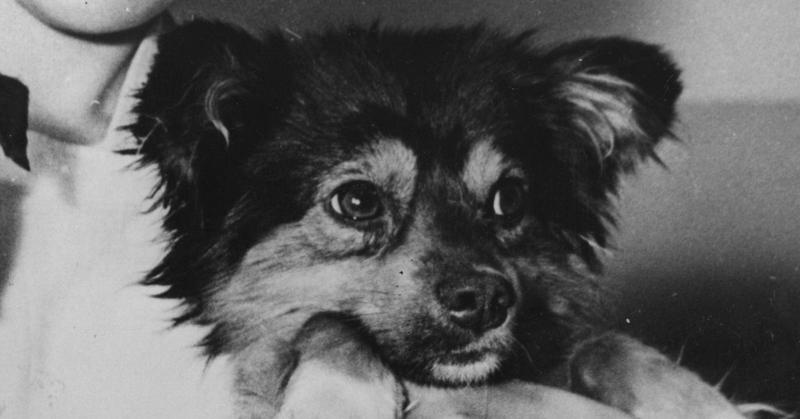Astro, Benji, Checkers: Famous Dogs Of The '50s, '60s And '70s
By | May 23, 2018

The house with the picket fence, the two car garage, some whole number of kids and a pooch in the yard -- that was the American dream of the postwar years. Dogs were plentiful; and in this age of dogs, famous dogs thrived. There were dogs in the White House, dogs in space, dogs of war, dogs in cartoons, dogs with their own movie franchise and officially licensed thermos and lunchbox set.
During the 1950s, '60s, and '70s, numerous dogs proved that they are man’s best friend through their heroic deeds, by servicing as goodwill ambassadors, or by simply entertaining us. These canine celebrities have earned a place in our hearts. Whether real or fictional, the pooches of the '50s, '60s, and '70s are representatives of their era and their fascinating stories give us a glimpse in to life in the sixties and seventies.
Checkers Was The Most Famous Dog In Politics

Checkers, a cocker spaniel owned by Richard Nixon, helped to keep his owner’s political career intact and his White House aspirations alive, though, sadly, he didn’t live to see Nixon win the presidency in 1969. Without Checkers, Nixon may never have achieved the pinnacle of politics. In fact, Nixon, the Republican vice presidential nominee and running mate of Eisenhower, was poised to fall out of political favor among the American public after being accused of benefiting from a trust fund that was established for a future Senate campaign. Eisenhower was ready to drop Nixon from the ticket. Then came the 1952 “Checkers Speech” in which Nixon denied any wrong doing. Nixon included references to his dog, Checkers, a gift from a political supporter, noting how much he and his family loved the dog and announced his intention to keep the pooch. That single dog reference helped to bolster Nixon’s credibility. After the speech, Eisenhower’s wife, Mamie, told her husband that any man who loves his dog that much must be an honest man. Nixon’s political career was saved and Checkers went on to enjoy a degree of celebrity throughout the early 1960s, until his death at age 13 in 1964.
Astro, The Dog Of The Future

Hanna-Barbera’s hit cartoon sitcom The Jetsons aired in primetime in 1962 and 1963 and presented a comic version of what the space-age future would look like. As space exploration came to the forefront, pop culture embraced the ideas of a futuristic space-age society. A few episodes into The Jetsons, viewers were introduced to Astro, the clumsy, inept stray dog. The Jetson family all want to keep Astro, except for the family patriarch, George. When Astro inadvertently catches a burglar, George finally gives in and the loveable pooch with the ability to speak – even though many of the sounds are replaced by an R sound – ends up becoming George’s best friend and confidant. Astro is featured prominently in the show’s opening credits when George is walking Astro on a treadmill. A cat wanders in and Astro chases it, can George is caught on the fast-moving machine, yelling his trademark phrase, “Jane! Stop this crazy thing!” The voicing of Astro by Don Messick, and the unique R-heavy vocal pattern, inspired Messick’s vocalization of another quintessential cartoon dog of the day, Scooby Doo.
Nemo, Doggie War Hero

A German shepherd named Nemo became a war hero on December 3, 1966, in Vietnam. While on patrol with his handler, Airman Second Class Robert Thorneburg, Nemo alerted Thorneberg to approaching enemy soldiers. Shots rang out before Thorneberg could radio for backup. Thorneberg was hit in the shoulder and Nemo had a bullet enter is eye and exit through his snout. Despite his injury, the loyal Nemo rushed the four enemy soldiers, diverting their attention long enough for Thorneberg to call for help. Nemo and Thorneberg were rescued and both survived the attack, although Nemo lost his eye. The heroic war dog was sent back to the United States, and lived out the remainder of his life at Lackland Air Force Base in Texas.
Scooby Doo, Mystery-Solving Dog

A cultural icon, the giant yet cowardly Great Dane named Scooby Doo became a staple of animated TV throughout the 1970s. Voiced by Don Messick who also gave voice to Astro, Scooby Doo had a number of human skills, such as speech, walking on two legs, and, when needed, driving the Mystery Machine. Created by Hanna-Barbera, the cartoon was created in response to parent complaints that too many animated television shows showed violence. Wildly popular, Scooby Doo led to an uptick in Great Danes as pets and the TV show, Scooby Doo, Where Are You?, spawned several spin-off shows, additional characters, and both animated and live action motion pictures.
Dogs In Space

On August 19, 1960, two Soviet Dogs, Belka and Strelka, became the first living creatures to travel into space and return safely back to Earth. Belka and Strelka survived their space travel, unlike their predecessor, Laika, the first dog launched into space that perished aboard the Sputnik 2 in 1957. A year after her out-of-this world adventure, Strelka gave birth to a litter of six puppies. One of the pups, Pushinka, was given to President John Kennedy as a personal gift from Soviet leader Nikita Khrushchev in 1961.
Benji, Dog Star Of The Silver Screen

Released in 1974, Benji, a film about a loveable stray dog that thwarts a local kidnapping, was a box office hit and the beginning of a six-film franchise. The clever, adorable mutt offered a reprieve from the social and political turmoil of the day and offered a family-friendly movie in contrast to the year’s other flicks, The Texas Chainsaw Massacre, The Towering Inferno, and Godfather, Part II. Benji was played by a dog named Higgins, who had appeared on Petticoat Junction and The Beverly Hillbillies.
